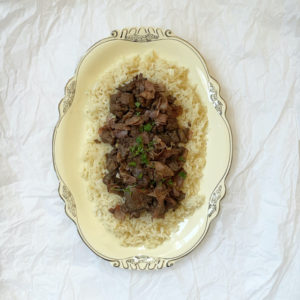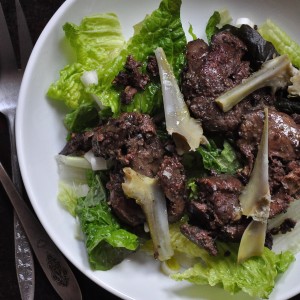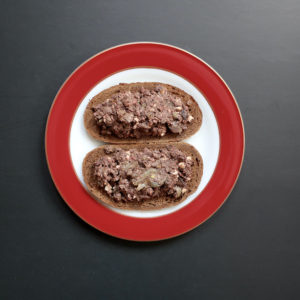Sauteed Chicken Livers
Chicken livers were standard fare during my childhood. Nobody was freaked by their being offal. Nor were they cooed over as nose-to-tail eating, because the concept didn’t exist yet. Back then, people just ate.
We also walked miles in the snow.
Back then there was snow to walk in. But that’s another story. Today we are discussing chicken livers.

A search through my recipe books confirms this recipe is Jewish in origin, like me. Before anyone sends for the Authenticity Police, let me add that chicken livers are enjoyed worldwide, in a variety of preparations. The French turn them into paté; the Chinese stir-fry them; the Italians serve them in tomato sauce. The Polynesians are famous for wrapping their chicken livers with bacon, slipping a water chestnut in for good measure.

(Husband’s X-mas party was at Berkeley Marina. Much prettier than a chicken liver. Golden Gate Bridge at left.)
However you serve your chicken livers, you must not overcook them. An overcooked chicken liver is nearly as upsetting as the news. But not quite.
Chicken livers do best when prepared in nonstick or well-seasoned cast-iron pans. Otherwise, sticking, and stress, and who needs that? Life is stressful enough, especially now. (I write just before Christmas.)

(I kept leaving the party to take pictures. You would have, too.)
I try not to pester people about buying organic foods, because organic foods are costly and people who insist you purchase them are annoying. But organic chicken livers, like the organic chickens they hail from, are less likely to be full of cancer-causing chemicals.
Lecture concluded.

Chicken livers–again, like chickens–have an affinity for citrus, especially lemon. They also play well with spices like paprika, cumin, coriander, and cayenne pepper. Chicken livers dusted with sumac are wonderful. Garlic is always a good thing in a pan of frying livers, as is a drip of booze. Marsala, Madeira, port, sherry, Vermouth, plain old white wine: are all divine.
(but not at the same time.)
(She makes a bad rhyme.)

Serving suggestions are nearly endless. Consider a bed of couscous, all manner of noodles, polenta, rice, or even some plain iceberg lettuce. The combination of hot and soft with crunchy and cold is marvelous.

Sauteéd Chicken Livers
yield: four servings
Preparation time: about 20 minutes
Please read notes concerning seasoning livers.
1 pound/454 grams organic chicken livers, washed and trimmed of bile ducts (see instructions, below)
1 large egg (optional)
3/4 cup/12 ounces/340 grams flour
2 teaspoons salt
1 teaspoon black pepper
1/2 teaspoon sweet paprika
1/8 teaspoon picanté paprika
1 teaspoon coriander seeds
1 teaspoon fennel seeds
1-2 garlic cloves, peeled and minced
olive oil, for the pan
a little butter, for the pan
1 ounce/28 grams Marsala, Madeira, sherry, port, Vermouth, or white wine for the pan (optional)
fresh lemon juice, for seasoning
Instructions
as always * denotes resting points.
To make this recipe, you’ll need:
-a colander to rinse and drain the livers
-paper towelling
-two large bowls.
-a scissors or small, very sharp knife
-If your coriander and fennel seeds are whole, a mortar and pestle or grinder.
-a spatula
-a large nonstick or well-seasoned cast iron frying pan: about 14 inch/35 cm
-a large plate or platter
If your livers are frozen, be sure to defrost them ahead of time. Chicken livers are highly perishable, so defrost them in the refrigerator.
To wash the livers:
Place colander in sink. Tip livers in. Run cool water over them, ensuring each is washed. I do this with clean hands, but use a spatula if you prefer.
To trim the bile sacs, look for small, round green sacs. Not all the livers may have them.You don’t want to cook these, as they taste terribly bitter. I find it easiest to trim them with scissors directly in the colander. Or use your small knife. Discard.
Pat livers very dry with paper towel. Again, I do this right in the colander, leaving it in the sink to drain, draping a few paper towels atop the livers. Wash your hands well with soap and hot water.
Leave livers in sink, or if you wish to take a break *, place colander in a deep plate or pasta bowl and refrigerate.
*
Crack the egg into one of the bowls, whisk lightly, and set aside.
*
Mix the seasoned flour: in your other bowl, mix the flour, salt, pepper, and paprikas.
Grind the coriander and fennel seeds and add them to the seasoned flour. Mix with a fork.
*
Bread the livers:
Remove the livers from the refrigerator, if you put them there, or the sink, and place them right into the egg bowl. Swish them around so each is eggy, then move them, a few at a time, into the flour bowl. There’s wisdom about keeping one hand dry and all that, which I forget, and we’re working with small amounts here. Hope nobody telephones or rings the doorbell. Why are they bothering you now, anyway?
Leave the breaded livers in the bowl and wash your hands in cold water, which does a better job of removing flour: heat activates gluten.
Set your large plate or platter beside the stove.
Place your pan on the stove. Pour in enough olive oil to generously coat bottom of pan–at least two tablespoons. Add about a half teaspoon of butter, which keeps the oil from burning. Turn the heat to medium low and allow butter to melt.
Now add the garlic and the liquor, if using. After thirty seconds or so, add the livers.
Turn the heat up slightly. You want a good sizzle. The exteriors of livers should begin cooking but not burning. If they start to, or all the liquid bubbles away, turn the heat down.
If more liquid is needed, you can add more liquor or even plain water. It’s okay to pour in a bit more olive oil, but you don’t want oily livers.
Cook the livers three to five minutes a side. You’ll know it’s time to turn them over when cooking juices well up (i.e., blood) through the livers. It will be evident. Don’t fuss with the livers: be patient. It will happen quickly. Flip livers and cook a few more minutes, until the insides are pink and moussey, not gray. You can cut into them with your spatula to check. The livers may not finish cooking simultaneously, so have your plate or platter handy to remove them as they’re ready.
Larger pieces may need another turn and a few more minutes. Total cooking time will be about ten minutes.
Livers are terminally brown food, so don’t fret over appearances. Taste: a squeeze of lemon pulls everything together here.
Serve chicken livers with salad, mashed potatoes, noodles, couscous, polenta, or rice.
Chicken livers keep, refrigerated, about five days. Freezing is possible but not recommended, as flavor and texture suffer.
Notes:
The seasoned flour may be adjusted to your taste. Increase or decrease the paprikas; add cayenne pepper, or alter the flavor profile by using spices like white and Szechuan peppercorns. Experiment.
Egg isn’t technically necessary in this recipe, but it’s what I grew up with. You are welcome to omit it: just dust livers with the flour mixture.
Fresh lemon juice is natural antibacterial. Lacking a dishwasher, I use it on my sink and hands after handling raw chicken livers. I also wash my sponge in the washing machine.
Variation: Add panko to the recipe for a crunchier exterior. To do this, crack one egg into one bowl, use one cup/464g panko in a second bowl, and the seasoned flour, as above, in a third bowl. Make the recipe as above.





